Functional
Genome Analysis (B070)
Deutsches
Krebsforschungszentrum,
Im Neuenheimer Feld 580
D-69120
Heidelberg,
Germany. |
 |
.
.
..
..
|
|
|
With
sequencing technology having entered a "next"
(actually
third)
phase, experimental procedures for the elucidation of cellular
effects and
functional consequences of variations in the encoded information have
become an emphasis of genomic studies..In the
early- to mid-ninties of the last century, DNA microarrays
established themselves
as an initial important
methodology for the performance of such analyses. Since its
early
stages, we have had a
continuous interest in microarray technology. Meanwhile, most
applications of DNA microarrays are done in
a
routine manner and many actually have become
obsolete because of better (sequencing) techniques.
..
Figure legend. Very early
experiment toward the
production of oligonucleotide microarrays by light-directed in situ
synthesis. A pattern that resembled a text was repeatedly projected
onto a
glass
surface, triggering oligomer synthesis. Subsequenly, a fluorescently
labelled
oligonucleotide of complementary sequence was hybridised to this chip,
producing the pattern shown.
..
Hoheisel, J.D. (2006) Nature
Rev. Genet. 7, 200-210.  More recent DNA technologies
particularly aim at regulating
or editing genes. One focus are
the application of genome-wide
screens
for the identification of essential genes, synthetic lethal
gene-drug or gene-gene combinations toward the development of
combinatorial treatment
modalities, which
are likely to be prerequisite for future cancer treatment. We are
pursuing the use of lentiviral short-hairpin
RNA libraries and the CRISPR-Cas system toward such
ends.
More recent DNA technologies
particularly aim at regulating
or editing genes. One focus are
the application of genome-wide
screens
for the identification of essential genes, synthetic lethal
gene-drug or gene-gene combinations toward the development of
combinatorial treatment
modalities, which
are likely to be prerequisite for future cancer treatment. We are
pursuing the use of lentiviral short-hairpin
RNA libraries and the CRISPR-Cas system toward such
ends.
|
...
.
FINISHED
PROJECT:
Technical
advances in the production of DNA-microarrays
Different methods for the
creation
of DNA-microarrays were used, but the basic idea on how to perform
analyses remained the same: Interaction
- mostly hybridisation of a
nucleic acid - of an unknown sample with an
ordered
array of immobilised DNA sensor molecules of known sequence produced a
specific pattern, which could be analysed or compared to a
given
standard. The sensor molecules consisted either of synthetic
oligomers
or - in very early projects - longer, enzymatically generated DNA,
mostly PCR-products made from
genomic DNA or cDNA clones. Hybridisation techniques, on their own or
in combination
with enzymatic reactions, opened up many avenues of genetic analyses.
..
Very
many aspects that
influence the
production of DNA-microarrays were investigated. Besides normal
synthesis procedures, also the photo-controlled in situ synthesis process was
improved dramatically in
terms of yield. In addition, methods for the inversion of the
oligonucleotides‘
synthesis direction were developed and the relevant monomers
synthesised,
permitting on-chip polymerase reactions, for example. Much of this work
was patented and licensed out.
..
Our
early work at
technical aspects of
DNA-microarray production
can be sub-divided into the following areas:
|
FINISHED
PROJECT:
aa
MolTools: Advanced molecular
tools for array-based analyses of genomes, transcriptomes, proteomes
and cells. |
  |
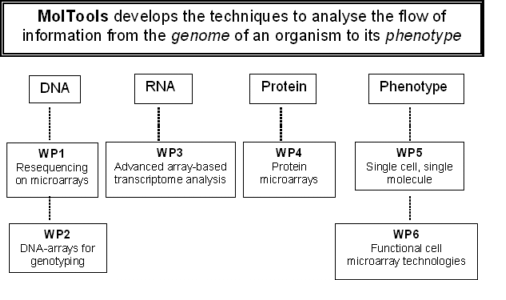 The MolTools
consortium
brought together 12 leading European academic groups, five biotech
companies
and one US laboratory
working in the area of postgenomic technology development.
The partners had pioneered a series of important molecular techniques
and worked
at the establishment of next-generation tools for molecular
analysis.
Molecular
technologies are in a very rapid state of development and the scope for
improvement is extreme. Also, methods are frequently rate-limiting for
the
progress
of biology and biotechnology generally. MolTools represented
an
important
initiative to integrate leading European scientists active in an area
of
technology development. Overall
coordination
rested with Ulf Landegren of Uppsala University. The project was organised in six interrelated
workpackages
(WPs) .
...
Scientific
aims were the establishment of genome analysis technologies
set to
monitor extensive molecular repertoires, and with the capacity to
investigate
even single molecules. To this end, powerful array-based research tools
were
developed to examine DNA, RNA and proteins.
...
We
were working particularly on
projects
as part of WP2, WP3 and WP4. One
project was the establishment of a universal
microarray as described below, utilising L-DNA,
the mirror-image form of the naturally occurring D-conformation of DNA.
Highly sensitive
transcript profiling and the establishment of protocols and
procedures for the
production and use of protein and particularly antibody
microarrays were the
focus in the respective workpackages. The MolTools
consortium
brought together 12 leading European academic groups, five biotech
companies
and one US laboratory
working in the area of postgenomic technology development.
The partners had pioneered a series of important molecular techniques
and worked
at the establishment of next-generation tools for molecular
analysis.
Molecular
technologies are in a very rapid state of development and the scope for
improvement is extreme. Also, methods are frequently rate-limiting for
the
progress
of biology and biotechnology generally. MolTools represented
an
important
initiative to integrate leading European scientists active in an area
of
technology development. Overall
coordination
rested with Ulf Landegren of Uppsala University. The project was organised in six interrelated
workpackages
(WPs) .
...
Scientific
aims were the establishment of genome analysis technologies
set to
monitor extensive molecular repertoires, and with the capacity to
investigate
even single molecules. To this end, powerful array-based research tools
were
developed to examine DNA, RNA and proteins.
...
We
were working particularly on
projects
as part of WP2, WP3 and WP4. One
project was the establishment of a universal
microarray as described below, utilising L-DNA,
the mirror-image form of the naturally occurring D-conformation of DNA.
Highly sensitive
transcript profiling and the establishment of protocols and
procedures for the
production and use of protein and particularly antibody
microarrays were the
focus in the respective workpackages.
|
|
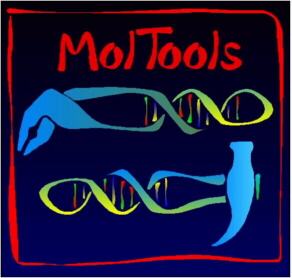
Participants:

Coordination:
..
WP1/WP2: Ivo
Gut
..
WP3:
Hans Lehrach
..
WP4:
Jörg D. Hoheisel
..
WP5:
Jorn Koch
..
WP6:
Olli Kallioniemi |
|
| FINISHED
PROJECT: |
|
Analysis
of transcription factor binding specificities; applications for the
identification of genes predisposing to cancer
|
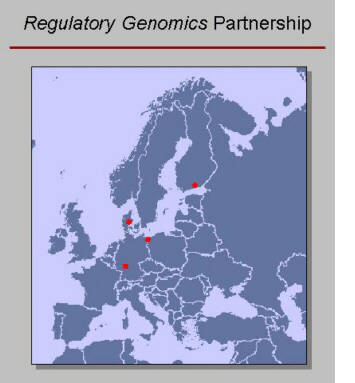 |
Determination of the
sequence of the human genome
and knowledge of the genetic code through which mRNA is translated have
allowed
rapid progress in the identification of mammalian proteins. However,
less
is known
about the molecular mechanisms that control expression of human genes
and
about the variations in gene expression that underlie many pathological
states,
including cancer. This is caused in part by lack of information about
the
'second genetic code' - binding specificities of transcription factors.
...
Deciphering
this regulatory code is critical for cancer research, as
too little is
known about the mechanisms by which the known genetic defects induce
the
transcriptional programs that control cell proliferation, survival and
angiogenesis. In addition, changes in binding of transcription factors
caused
by single nucleotide polymorphisms (SNPs) are likely to be a major
factor in
many quantitative trait conditions, including familial predisposition
to
cancer.
...
We
aim
at
developing novel genomics tools and methods for
determination of
transcription factor binding specificity. These tools are used for
identification of regulatory SNPs that predispose to colorectal cancer,
and for
the characterisation of downstream target genes that are common to
multiple
oncogenic transcription factors.
For
more information
click on
Helwa & Hoheisel (2010) Anal. Bioanal. Chem. 398, 2551-2561.  |
|
FINISHED
PROJECT:
aa
Universal
Microarrays: Utilising the
left-helical conformation of L-DNA
for analysing different marker types
on a single universal microarray platform |



|
We
werepursuing the establishment of a microarray platform that is not
assaying
one specific biological issue at a time – such as transcription
profiles,
genotypes or protein-DNA interactions, respectively – but would allow a
simultaneous analysis of all these and other aspects in a single
experiment.
Such an array would allow combining different kinds of molecular
markers for a
more accurate and informative diagnosis. Especially for analyses on
samples of
limited quantity, simultaneous assaying might become important. For
many
assays, it would also be advantageous to perform the actual reaction in
homogenous solution rather than on a solid support, since the presence
of a
surface influences many reactions negatively.
...
A
universal
ZIP-code microarray is one option to such ends. This type of
microarray
contains a set of unique and distinct (ZIP-code) oligonucleotides that
should
not have any complementary sequence in nature and are made solely
for the
purpose of addressing with a complementary oligonucleotide a particular
microarray
location.
The oligonucleotides have similar
thermodynamic properties so that hybridisation can be performed at one
experimental condition with identical stringency. Instead of producing
many different microarrays, a single design can be used for a variety
of
assays. The actual analysis is carried out with a mixture of probe or
primer
molecules in homogenous solution. Each oligonucleotide of the mixture
is
composed of an assay-specific sequence portion, which is linked to a
distinct
ZIP-code (a tag-sequence). Only subsequent to the
analysis-reaction,
the molecules are physically separated by hybridisation to the ZIP-code
microarray and therefore made available to individual signal scoring.
All probe
molecules could assay the same kind of information, such as transcript
levels
for example, or different types of analysis could be combined.
...
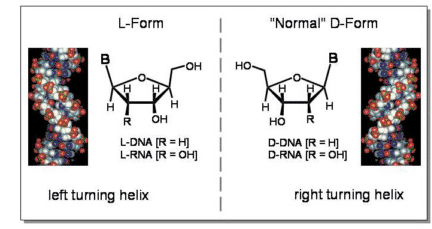 However,
the aspect of
avoiding tag-sequences that exhibit similarity to any genome is
difficult to
achieve. Worse, even very short sequence homologies already lead to
some
cross-hybridisation and thus a sequence-dependent accumulation of
background
signal, if complex samples are hybridised. The use of L-DNA could solve
this
problem. L-DNA is the perfect mirror-image form of the
naturally occurring D-conformation of DNA. Therefore, L-DNA duplexes
have the
same physical characteristics in terms of solubility, duplex stability
and
selectivity as D-DNA but form a left-helical double-helix. Because of
its
chiral difference, L-DNA does not bind to its naturally occurring D-DNA
counterpart, however. For all the differences, L-DNA is nevertheless
chemically
fully compatible with the D-form of DNA, so that chimeric molecules can
be
synthesised. Also
in
terms of stability in an impure environment, L-DNA microarrays could be
superior,
since L-DNA is no substrate for any known enzymatic degradation. The
microarrays could therefore be positioned in a fluidic system through
which
there is a continuous flow of biological material. Apart from handling
advantages, more molecules could be captured in a prolonged incubation
in a
continuous flow system, thus accumulating signal. This could be
important for
analysing fermentation or production processes, for example, and fits
well with
currently ongoing developments toward small-scale lab-on-chip devices.
...
Toward a
systematic understanding of the processes involved in cellular
functioning at
the levels of DNA, RNA and protein, we also utilise L-DNA for
experiments
in the field of synthetic
biology. However,
the aspect of
avoiding tag-sequences that exhibit similarity to any genome is
difficult to
achieve. Worse, even very short sequence homologies already lead to
some
cross-hybridisation and thus a sequence-dependent accumulation of
background
signal, if complex samples are hybridised. The use of L-DNA could solve
this
problem. L-DNA is the perfect mirror-image form of the
naturally occurring D-conformation of DNA. Therefore, L-DNA duplexes
have the
same physical characteristics in terms of solubility, duplex stability
and
selectivity as D-DNA but form a left-helical double-helix. Because of
its
chiral difference, L-DNA does not bind to its naturally occurring D-DNA
counterpart, however. For all the differences, L-DNA is nevertheless
chemically
fully compatible with the D-form of DNA, so that chimeric molecules can
be
synthesised. Also
in
terms of stability in an impure environment, L-DNA microarrays could be
superior,
since L-DNA is no substrate for any known enzymatic degradation. The
microarrays could therefore be positioned in a fluidic system through
which
there is a continuous flow of biological material. Apart from handling
advantages, more molecules could be captured in a prolonged incubation
in a
continuous flow system, thus accumulating signal. This could be
important for
analysing fermentation or production processes, for example, and fits
well with
currently ongoing developments toward small-scale lab-on-chip devices.
...
Toward a
systematic understanding of the processes involved in cellular
functioning at
the levels of DNA, RNA and protein, we also utilise L-DNA for
experiments
in the field of synthetic
biology.
Hauser et al.
(2006) Nucleic Acids Res. 34, 5101-5111. 
Hoheisel, J.D. (2006) Nature
Rev. Genet. 7, 200-210. 
|
.
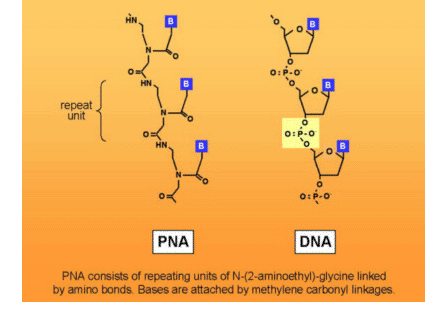 FINISHED
PROJECT: FINISHED
PROJECT:
sncRNAomics – High throughput comparative sncRNAome
analysis in major Gram-positive human pathogenic bacteria: functional
characterisation by a systems biology approach and peptide nucleic acid
(PNA) drug
design


Small
non-coding RNAs (sncRNAs) and especially microRNAs
(miRNAs)
have been identified as key regulators of several cellular processes.
In
bacteria, sncRNAs have attracted considerable attention as an emerging
class of
gene expression regulators. The ERA-Net consortium sncRNAomics combined
bioinformatics, novel high-throughput sncRNA screening methods,
whole-genome
transcriptomics and proteomics, coupled to robust molecular
characterisation methods in order to provide comprehensive information
regarding production, regulation and pathogenic implications of sncRNAs
in five
major high-risk Gram-positive pathogens. This
information was used to design novel potential therapeutics based
on
sncRNA-complementary peptide nucleic acids (PNAs).
PNAs exhibit several advantageous features compared to common
nucleic acid therapeutic agents. As they lack the
phosphodiester
backbone, they are much more stable against enzymatic digestion and
display higher binding affinities in hybridising reactions. PNAs
designed to
bind tightly to target sncRNAs were constructed so as to penetrate the
bacterial
cell,
hybridise to
the respective sncRNA and counteract its effect in pathogenicity. In
parallel,
the knowledge gained in the project is used to develop sensitive
diagnostics, which should be able to detect sncRNAs in the
fmol range directly at point-of-care.
...
Based on
several earlier projects on PNA,
a technique was
established
of synthesising and purifying PNA
oligomers in
relatively small quantities but large numbers. PNAs are
produced by an automated process in filter-bottom microtiter plates.
The
resulting molecules are released from the solid support and purified by
taking advantage of terminal protection groups. In consequence, only
full-length PNA-oligomers are binding to the purification matrix
whereas
truncated
molecules, produced during synthesis because of incomplete condensation
reactions, do not bind. Different surface chemistries and fitting
modifications
of the PNA terminus have been established and filed for patent protection. Based on the results
and experience
obtained with PNA oligomers, also protocols
for the parallel synthesis
and purification of
peptides
were established, which are utilised by a
spin-off company
resulting from this project.
..
|
|
|
|
|
Patenge et
al. (2013) Mol. Ther. Nucleic Acids
2, e132. |
 |
|
Jacob et al. (2003) Peptide
Nucleic Acids
(Nielsen, P.E., ed.), 261-279. |
|
|
|
|
|
Mraheil et
al. (2010) Microb. Biotechnol. 3,
634-657. |
 |
|
Bauer et al.
(2003) Comp. Funct. Genom. 4,
520-524. |
 |
|
|
|
|
Jacob et
al.
(2006) Encyclop. Ref. Genomics Proteomics Mol. Med. , 1422-1425. |
 |
|
Brandt et al.
(2003) Nucleic Acids Res. 31,
e119. |
 |
|
|
|
|
Brandt et al.
(2006) Appl. Surface Sci. 252,
6935-6940. |
 |
|
Matysiak et al.
(2001) BioTechniques 31, 896-904. |
 |
|
|
|
|
Hellweg et
al. (2006) Appl. Surface Sci. 252,
6742-6745. |
 |
|
Matysiak et al. (1999) Nucl. & Nucl. 18, 1289-1291. |
 |
|
|
|
|
Brandt &
Hoheisel (2004) Trends
Biotechnol. 22, 617-622. |
 |
|
Matysiak et al. (1999) Peptide
Nucleic Acids
(Nielsen, P.E. & Egholm, M., eds.), 119-128. |
|
|
|
|
|
Arlinghaus et
al. (2004) Appl. Surface
Sci. 231-232, 392-396. |
 |
|
Weiler et al.
(1997) Nucleic Acids Res. 25, 2792-2799. |
 |
|
|
|
|
Jacob et al.
(2004) Methods Mol. Biol. 283 (Niemeyer,
C., ed.), 283-294. |
 |
|
|
|
|
|
|
|
|
.
|
|